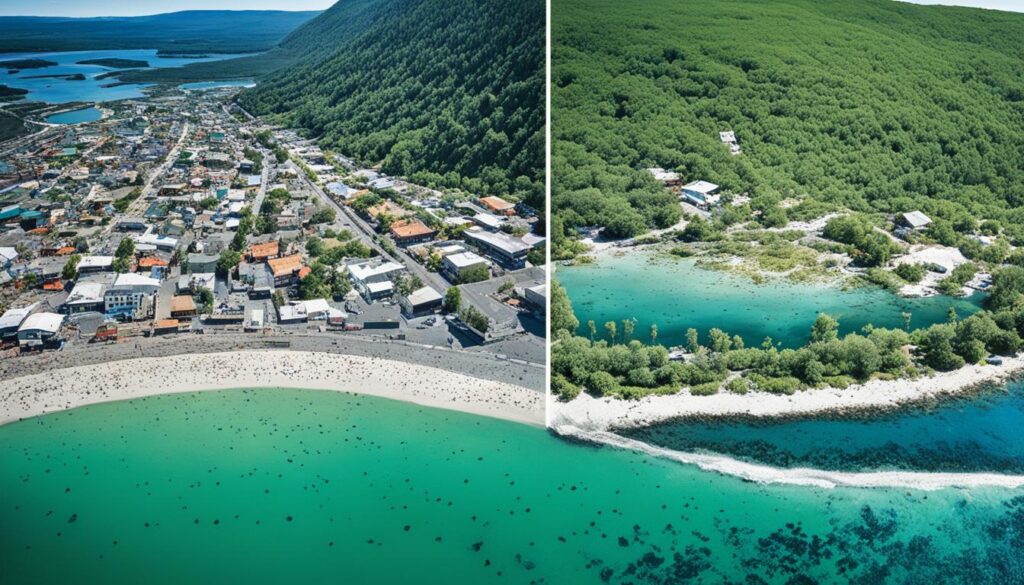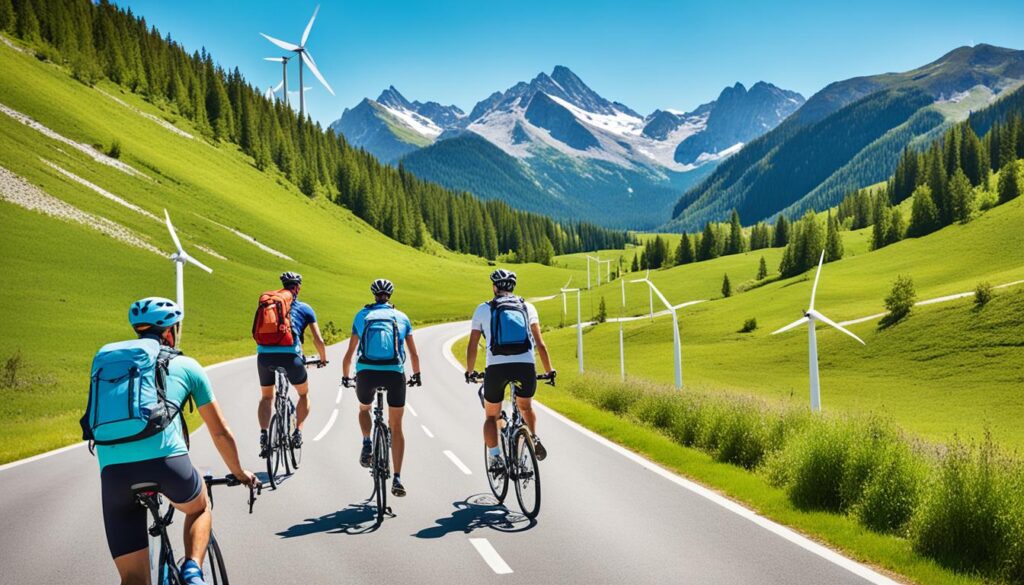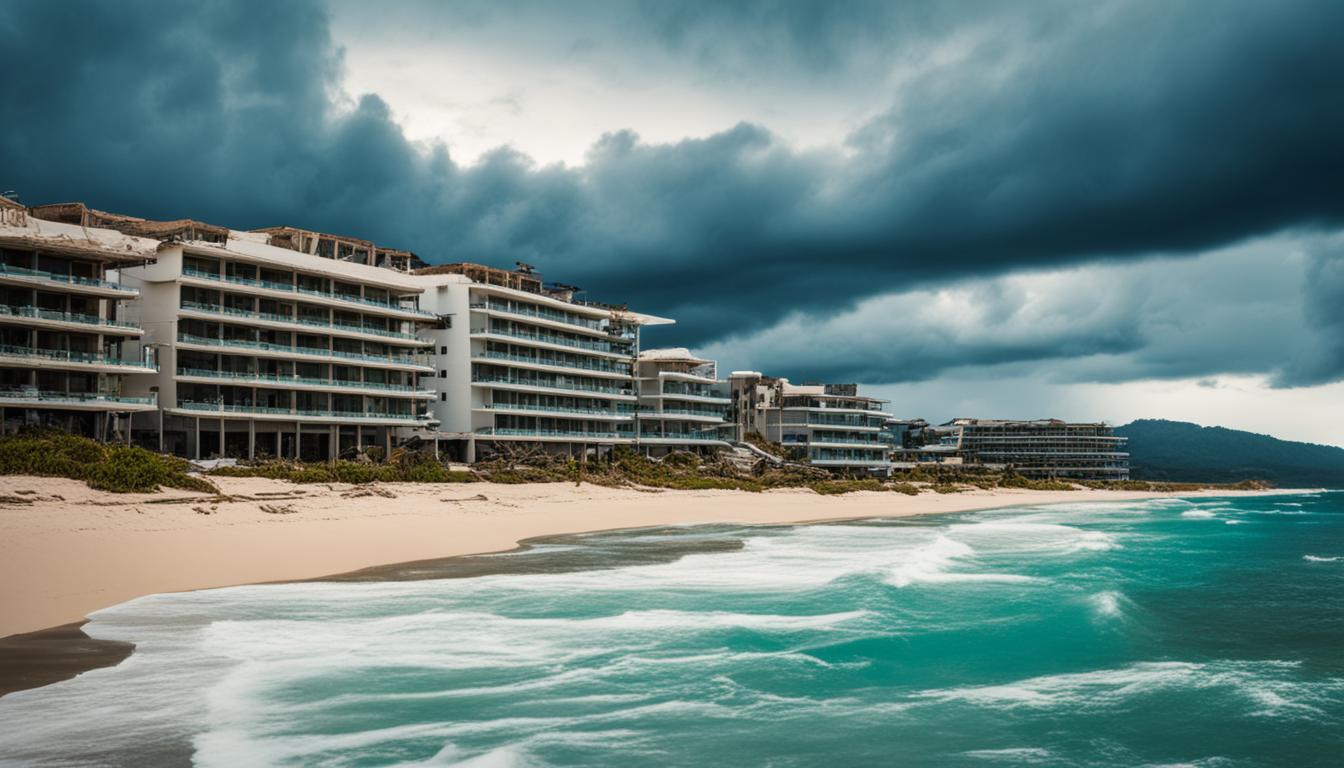Climate change is a big deal in tourism studies. It’s the top global issue today1. The tourism industry is already feeling the effects of climate change. It will greatly change tourism in the future, affecting where people go on holiday, the competitiveness of places, and how tourism helps countries develop.
Key Takeaways
- Climate change is the most significant global environmental and development challenge facing the world today.
- The tourism industry is already impacted by climate change and is expected to face significant changes in the 21st century.
- Climate change affects consumer travel decisions, tourism demand patterns, destination competitiveness and sustainability, and tourism’s role in international development.
- Understanding the climate change-tourism interface is crucial for the industry’s future resilience and adaptation.
- Addressing climate change mitigation and adaptation strategies in the tourism sector is essential for long-term sustainability.
The Climate Change and Tourism Interface
The tourism industry is very connected to the environment and climate. It’s as sensitive to climate change as agriculture, insurance, energy, and transportation2. At the same time, it’s a big source of greenhouse gases, making up about 5% of global emissions in 20053.
Exploring the Critical Relationship Between Tourism and Climate
A study looked at 3,556 articles about tourism and climate change, with 3,400 in English3. From 2012 to 2022, the number of studies on this topic almost tripled3. The USA, United Kingdom, Australia, China, Spain, Canada, Germany, Italy, and South Africa lead in research on tourism and climate change3.
Understanding Tourism’s Vulnerability to Climate Fluctuations
Climate change will bring big changes for tourism businesses and destinations4. We need to cut down on greenhouse gas emissions, including in tourism4. Even though there’s more research, tourism hasn’t really changed how it deals with climate change4.
The Tourism Climate Change Knowledge System includes inputs, processes, environment, outputs, and feedbacks4. Most research looks at tourism and climate change globally, but reports focus on certain areas or countries4.
“Incremental changes in the tourism sector will be insufficient to address the climate crisis, calling for a paradigm shift.”4
In 2003, there wasn’t much research on how tourism and climate change interact2. A workshop in Warsaw in November 2003 aimed to connect scientists and stakeholders. It also planned for more research in this area2.
Growth in Tourism’s Carbon Footprint
The tourism industry is growing fast, with more people visiting and spending money each year. This growth is happening at a rate of 3-5% annually5. But, this growth is harming the environment. The tourism sector is now a big part of global carbon emissions.
The Davos Declaration on Climate Change and Tourism calls for action6. It says the tourism industry must act fast to reduce its carbon emissions. A study in Nature Climate Change found that tourism’s carbon emissions went up from 3.9 to 4.5 GtCO2e between 2009 and 20135.
Research by the UNWTO and others has looked into how tourism affects the environment6. They’ve studied how air travel impacts climate change. The findings are concerning.
Tourism’s carbon footprint is about 8% of global emissions. In 2013, it was estimated at around 2.9 GtCO2e5. The US, China, Germany, and India lead in tourism emissions. But small island nations like the Maldives and Mauritius have high emissions per visitor7.
By 2025, tourism’s emissions could jump to 5-6.5bn tonnes of CO2eq7. This would be about 12% of global emissions. It could also hinder efforts to fight climate change7.
To fix this, we need to use carbon taxes and stricter rules on aviation and shipping7. We also need to promote sustainable tourism. Taking action is crucial to meet global climate goals and lower emissions.
Climate Change Mitigation Strategies for Tourism
The tourism industry faces a big challenge with its carbon footprint. It makes up about 8% of global carbon emissions. This is mainly from transportation, shopping, and eating out8.
To tackle this, the tourism industry is looking at sustainable tourism practices and carbon management efforts. Nature-based Solutions (NbS) could help cut emissions by 30-37%. In 2020, investments in NbS hit US $133 billion, and the UN says we need three times that by 20408.
The industry is also working on reducing emissions. Over 300 stakeholders signed the Glasgow Declaration on Climate Action in Tourism. This aims to halve carbon dioxide emissions by 20308. Also, $40 billion of a $100 billion yearly fund will help with adaptation costs, especially for island nations and developing countries8.
As the tourism industry changes, carbon management practices and sustainable tourism will be key. These efforts help the industry fight climate change. By adopting these strategies, tourism can help solve the climate change problem8910.,
| Mitigation Strategies | Sustainable Practices | Carbon Management Initiatives |
|---|---|---|
| Nature-based Solutions (NbS) | Reducing emissions from transportation | Investments in renewable energy |
| Emissions reduction targets | Promoting eco-tourism and environmentally friendly activities | Offsetting carbon footprint |
| Adaptation measures | Encouraging sustainable accommodation and dining options | Implementing energy-efficient practices |
Exploring Carbon Management Practices in the Tourism Sector
The tourism industry is working hard to manage its carbon footprint. Research shows CO2 emissions from tourism could jump by 25% by 20309. In 2016, tourism’s transport emissions made up 5% of all man-made emissions and could hit 5.3% by 20309.
The sector is joining the UN’s climate talks since COP25 in 2019. Over 300 stakeholders signed the Glasgow Declaration. They aim to halve emissions by 2030 and achieve net zero by 20509.
“The tourism industry is taking significant steps towards emissions reduction. The Glasgow Declaration on Climate Action in Tourism, signed by over 300 stakeholders, aims to halve carbon dioxide emissions by 2030.”
By focusing on carbon management practices and global climate goals, the tourism industry can help fight climate change. This ensures a sustainable future for tourism910.,
Impacts of Climate Change on Tourist Destinations
Climate change is hitting tourist spots all over the world. Coastal areas see sea levels go up by about 3.2 millimeters each year. This could make them less good for tourism11. Also, rising global temperatures might make some places too hot for visitors, which could lead to fewer tourists11.
Climate change is also hurting the natural beauty that draws tourists. For example, 50% of the world’s coral reefs have vanished due to warmer oceans from climate change. This hurts places that depend on eco-tourism11. The tourism industry itself is responsible for about 8% of global carbon emissions, adding to the problem11.
Climate change affects many parts of the tourism experience. Meat eating is a big part of greenhouse gas emissions, so eating more plant-based while traveling is a good idea11. Using buses and trains a lot also adds to greenhouse gases, so taking public transport helps the environment11. Laws in places like the UK aim to cut carbon emissions, showing how policy can fight climate change11.
Climate change can also make it harder to get to tourist spots. Things like storms, cyclones, and fires can mess with transport, water, and the appeal of places11. Places for winter sports are especially at risk as global warming makes snow less common and the season shorter11.
To deal with climate change, tourist spots need to adapt. This could mean promoting off-peak travel, keeping ski resorts open all year, and building strong against disasters11. By tackling climate change head-on, tourist spots can stay popular and strong despite the changes.
“Though tourism contributes to 11% of global greenhouse gas emissions, it holds potential for solutions to climate change through sustainable practices.”12
Adaptation Measures for Governments, Industry, and Destinations
Climate change is changing the tourism world. Governments, the industry, and tourist spots need to make plans to handle these changes13. The European Commission has set priorities like boosting competitiveness and making tourism sustainable13.
Destinations must take steps to protect their tourism future13. The Copernicus Service European Tourism offers climate info to help plan for changes13. The Interreg Euro-MED programme also supports sustainable tourism in the Mediterranean13.
Building Resilient Tourism Ecosystems
Working together is key to adapting to climate change13. Tourism links with many areas like nature, city planning, and disaster management13. Partnerships across sectors help find solutions to climate challenges13.
The European Commission’s COSME program helps fund sustainable tourism projects13. Projects focus on eco-friendly, sports, food, wine, and health tourism13. Important indicators like water temperature and snow levels track how climate change affects tourism13.
Tourism adds about 8% to global greenhouse gas emissions14. Destinations and businesses must cut their carbon footprint and get stronger14. Places like Whistler ski resort and Ziptrek Ecotours show how the industry can adapt14.
The tourism sector must work together to face climate change13. By joining forces, governments, the industry, and destinations can create a sustainable tourism future13.
climate change and tourism
Climate change is making it hard for the tourism industry to keep up with changing consumer habits and travel trends15. Tourism is responsible for 8% of the world’s carbon emissions15. Air travel emissions have jumped by 32% in recent years15. This is worrying, as experts say sea levels could rise by up to 3.6 feet by 2100 if emissions keep going up15. Also, coral bleaching is happening 5 times more often than before15.
Travelers are now thinking more about the environment and how their trips affect it16. The tourism industry is a big source of greenhouse gases, making up about 10% of them16. It’s expected to increase its emissions by 25% from 2016 to 203016. Places like the Alps, which get 120 million tourists a year16, and coastal areas, which are a big part of European and US tourism, are at risk from climate change.
Shifting Travel Patterns and Destination Preferences
People are looking for places that are tackling climate change16. Destinations that focus on being sustainable and adapting to climate change will attract more tourists16. Places that don’t adapt might see fewer visitors as people choose places that are better for the planet16.

The tourism industry needs to change to meet these new preferences and trends16. By cutting down on carbon emissions, building sustainable infrastructure, and planning for climate risks, places and businesses can do well in a changing climate16.
| Destination | Tourism Contribution to GDP | Climate Change Impacts |
|---|---|---|
| Greece | 15% | Rising sea levels, increased frequency of heatwaves and wildfires |
| Caribbean | Over 80% | Hurricanes, coral bleaching, rising sea levels |
| Aruba and the British Virgin Islands | Around 90% | Rising sea levels, increased storm intensity |
| Alps Region | N/A | 8.4% reduction in seasonal snow coverage per decade, increased risk of avalanches and landslides |
As the tourism industry faces climate change challenges, it’s key to understand what consumers want and adapt to their needs16.
The Economics of Climate Change for Tourism
Climate change is a big challenge for the tourism industry. If global temperatures go up by 4.5˚ C by 2100, it could cost the U.S. $520 billion a year17. The U.S. might lose a lot of money due to climate change, second only to India, according to a study17.
North America has faced climate disasters costing $415 billion over the last three years. Texas lost about $125 billion from Hurricane Harvey in 2017. Hurricane Sandy caused around $71 billion in damages in 201217. Warmer temperatures and rising sea levels make hurricanes more destructive17.
Climate change threatens agriculture too. The Midwest could lose up to 25% of its corn and soybean yield by 205017. Rising temperatures can cut crop production by 5-15% for every degree Celsius increase17. Sea level rise could cause trillions of dollars in infrastructure loss by the end of the century17.
The effects of climate change go beyond infrastructure and farming. A 4.5˚ C rise by 2090 could lead to 9,300 more deaths in U.S. cities from extreme heat, costing $140 billion a year17. Temperature extremes could cause two billion lost labor hours annually by 2090, costing $160 billion in wages17. Tourism could lose two billion dollars in winter recreation due to less snow and ice17.
Businesses face many challenges from climate change, like damage to infrastructure and water scarcity17. But, there are chances for the tourism industry to adapt and benefit from the climate change. A study found that improving green governance increased ecotourism in developing countries18. With better globalization, ecotourism also grew18.
The tourism industry must tackle the challenges of climate change while looking for opportunities. By understanding the economic effects and adopting strategies, the tourism sector can survive and grow in this changing world.
“The tourism industry must confront the economic realities of climate change head-on, but in doing so, it can also uncover innovative solutions and new avenues for growth.”
Sustainability and Tourism in the Era of Climate Change
The tourism industry is facing big challenges due to climate change. It needs to focus on sustainable tourism practices more than ever. The climate change tourism industry is dealing with issues like rising sea levels and more extreme weather19. To lessen its impact, the industry must use new sustainable tourism practices that care for the environment and are strong against climate change.
Traveling is a big part of the problem for the tourism industry’s environment1920. To fix this, the industry should look into ways to manage carbon emissions. This includes promoting green travel trends, using renewable energy, and encouraging sustainable transport. By doing this, the tourism sector can help fight climate change.
It’s also key for the industry to adapt to climate change20. This means taking steps like protecting coasts, offering different kinds of tourism, and getting ready for disasters. Working with governments, local people, and industry leaders can help make tourism strong and safe for the future21.
The tourism industry has a big role in fighting climate change1920. By choosing sustainable tourism practices, it can lessen its harm to the environment. This makes it a leader in making a better future. We need a team effort that focuses on reducing emissions and adapting to climate change. This way, the climate change tourism industry can stay strong and take care of the planet.

“The eventual magnitude of climate change and associated risks will be determined by choices to reduce GHG emissions made over the next 30 years.”19
Conclusion
The link between climate change and tourism is complex and pressing. This article has shown the need for the travel industry to change and use sustainable ways22. The tourism sector, which is a big source of carbon emissions, must act now to lessen its environmental harm and get ready for climate change’s effects11.
As the climate change tourism future comes to light, everyone in the tourism world must work together. This includes governments, companies, and travelers. They need to use tourism sustainability solutions22. This means cutting carbon emissions, making plans to bounce back from climate challenges, and changing how consumers act to support travel industry adaptation strategies6.
By taking these steps, the tourism industry can lessen its carbon footprint. It can also make the most of the new chances brought by climate change, like eco-tourism and the rise in demand for green travel11. As we face the big challenges of climate change, the tourism sector can show the way to a more sustainable and strong future for everyone22611.,,
FAQ
What is the significance of climate change for the tourism industry?
How does the tourism industry contribute to greenhouse gas emissions?
What is the purpose of this publication on climate change and tourism?
What are the key themes covered in the book “Tourism and Climate Change: Impacts, Adaptation and Mitigation”?
How does this book address the complexities of climate change and tourism?
What are the key SEO-relevant keywords for this content?
Source Links
- Tourism and Climate Change: Impacts, Adaptation and Mitigation
- Microsoft Word – Book_Nato.doc
- Evolving Narratives in Tourism and Climate Change Research: Trends, Gaps, and Future Directions
- The Tourism Climate Change Knowledge System
- Lenzen_et_al-2018-Nature_Climate_Change.pdf
- Climate Change and Travel: Harmonizing to Abate Impact
- Tourism responsible for 8% of global greenhouse gas emissions, study finds – Carbon Brief
- Climate Change and Tourism: How Destinations Are Responding to the Climate Crisis (Part 1) – Solimar International
- Climate Action | Transforming tourism for climate action
- How Climate Change Affects the Tourism Industry and Ways to Mitigate It – SanDiego350
- Impact of Climate Change on Tourism
- Tourism
- Climate Adaptation and Tourism – a Closer Link than We might Think? — Pacific Asia Travel Association
- Combat Climate Change – Sustainable Travel International
- Rising global temperatures are already affecting the tourism industry – here’s how
- How Climate Change Impacts the Economy
- Eco-tourism, climate change, and environmental policies: empirical evidence from developing economies – Humanities and Social Sciences Communications
- Sustainable Tourism and the Grand Challenge of Climate Change
- SDG 13 Climate Change Purpose Tourism For Sustainable Development — Earth Changers
- Tourism and Climate Change: a close-knit and complicated relationship
- 10.2 Tourism and Climate Change

